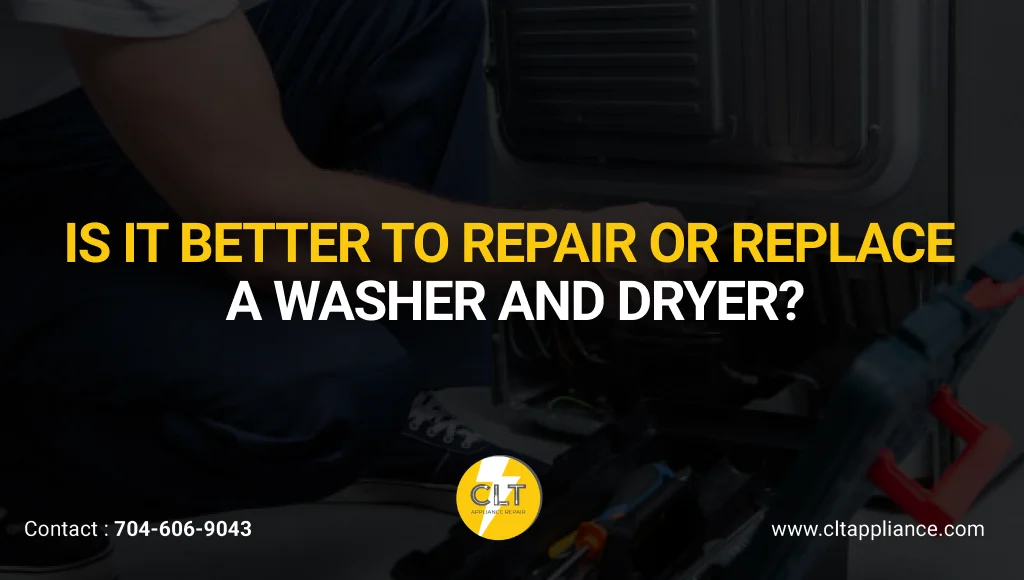[TL;DR]
The decision to repair or replace washers and dryers depends on age, repair costs, and frequency of problems. The 50% rule states that if repair costs exceed half the price of a new appliance, replacement makes financial sense. Appliances under five years old with minor issues typically warrant repair, while units over eight years old with major component failures often need replacement. Modern energy-efficient models can offset higher purchase costs through reduced utility bills over time.
- Washers last 10-12 years, dryers last 10-13 years on average
- Apply the 50% rule: repair if costs are under half of the replacement price
- Multiple repairs within two years usually indicate replacement time
Deciding what to do with a broken washer or dryer can feel overwhelming. One path leads to expensive repairs with no guarantees, while the other demands a hefty investment in new appliances. This decision affects household budgets, daily routines, and long-term satisfaction with laundry management. The choice becomes even more complex when considering energy efficiency, reliability, and professional dryer repair costs versus replacement expenses. Smart homeowners weigh multiple factors before committing to either option, ensuring they make the most cost-effective decision for their specific situation.
Keep your washer and dryer running smoothly with CLT Appliance Repair in Charlotte. Our certified technicians provide fast, reliable repair services for all major brands, handling everything from minor fixes to major component issues.
Book Repair: 704-606-9043
Should you repair or replace your broken washer or dryer?
Repair your washer or dryer if it’s under five years old and the repair costs are less than 50% of a new appliance’s price. Replace appliances over eight years old with major component failures or when facing multiple repairs within two years. Average lifespans of household appliances have remained steady or slightly declined over the past decade, depending on brand and usage. This trend makes strategic repair versus replacement decisions more critical than ever for homeowners.
Consider appliance age as a primary factor in your decision process. Younger appliances typically justify repair investments because they retain significant remaining lifespan. Older units approaching the end of their expected service life often make poor repair candidates even for moderate problems.
Quick decision framework:
- Under 5 years old: Almost always repaired unless catastrophic damage
- 5-8 years old: Repair if costs are under 40% of the replacement price
- Over 8 years old: Replace for major repairs over 50% of the new appliance cost
- Multiple recent repairs: Replace regardless of age
A professional assessment identifies whether the problem is a simple component failure or a more complex system issue. Qualified technicians can assess overall appliance condition and provide realistic repair versus replacement recommendations based on a comprehensive evaluation.
Key Factors to Consider
Several critical factors influence whether repairing or replacing washers and dryers makes financial sense. Understanding these elements helps homeowners make informed decisions that maximize value and minimize long-term costs.
Age of Appliance
Washers typically last 10-12 years, while dryers operate effectively for 10-13 years with proper maintenance. Age alone doesn’t determine replacement necessity, but it provides crucial context for repair decisions and expected remaining lifespan.
Appliances under five years old generally warrant repair consideration regardless of problem severity. These units retain significant remaining lifespan and often have warranty coverage that reduces repair costs. Manufacturing defects typically appear early, making repairs worthwhile investments in younger appliances.
Age-based decision guidelines:
- Under 5 years: Almost always repair unless catastrophic damage
- 5-8 years: Evaluate repair costs against remaining lifespan
- 8-10 years: Consider replacement for major component failures
- Over 10 years: Replacement often provides better long-term value
Appliances over eight years old with major component failures often make poor repair candidates. At this age, multiple systems may fail simultaneously, leading to cascading repair costs that exceed replacement value within short timeframes.
Cost of Repair vs. Replacement
The 50% rule provides a simple framework for repair versus replacement decisions. If repair costs exceed 50% of a new appliance’s price, replacement typically offers better long-term value and reliability for homeowners.
Calculate total repair costs, including labor, parts, service calls, and potential future repairs within the next two years. Compare this figure to new appliance prices from multiple retailers to establish accurate replacement costs for decision-making purposes.
Common repair cost ranges:
- Minor repairs (belts, filters, switches): $100-250
- Moderate repairs (pumps, motors, heating elements): $250-450
- Major repairs (control boards, transmissions, drums): $450-700+
Professional dryer repair for heating elements typically costs $200-350, while washer pump replacement ranges from $300-500, depending on model complexity. These moderate repair costs often fall below the 50% threshold for mid-range appliances.
Frequency and Type of Repairs
Multiple repairs within two years typically indicate systemic problems that make replacement more cost-effective than continued maintenance. Track repair frequency and costs to identify patterns that suggest approaching end-of-life conditions for aging appliances.
Certain repair types signal fundamental problems that often recur despite professional attention. Motor failures, control board malfunctions, and drum damage represent expensive fixes with uncertain longevity, making replacement consideration prudent for older appliances.
Red flag repairs indicating replacement:
- Motor or transmission failures in units over 7 years old
- Control board replacements costing over $400
- Drum damage requiring major disassembly
- Multiple component failures within 12 months
- Safety issues like electrical burns or water damage
Minor repairs like belt replacement, filter cleaning, or switch adjustments typically don’t indicate broader problems. These routine maintenance items extend appliance lifespan and represent good investments in properly functioning units with remaining useful life.
Energy Efficiency and Operating Costs
Modern washers and dryers consume significantly less energy and water than models manufactured before 2010. According to Consumer Reports data, all-in-one washers and dryers are highly energy efficient and consume 28% less energy than traditional dryers. Energy Star-certified appliances can reduce utility costs compared to older, less efficient models through improved technology and design.
High-efficiency washers use less energy and water than standard models. These savings accumulate over the appliance’s lifespan, potentially offsetting higher purchase prices through reduced operating costs and environmental benefits.
Efficiency comparison factors:
- Water usage: Older washers use more gallons per load than new models
- Energy consumption: Older dryers typically use more electricity
- Cycle times: Modern appliances often complete cycles more efficiently
- Maintenance requirements: Newer models typically need less frequent service
Calculate annual operating cost differences by comparing energy labels on current and potential replacement appliances. Consider efficiency benefits when evaluating repair versus replacement decisions for older, less efficient appliances.
Parts Availability and Warranty Coverage
Discontinued models often face parts availability challenges that make repairs expensive or impossible. Manufacturers typically discontinue parts production several years after model discontinuation, leaving owners with limited repair options for aging appliances.
New appliances include comprehensive warranties covering parts and labor for specified periods, depending on the manufacturer and component type. Extended warranties provide additional protection but require a cost-benefit analysis based on appliance reliability history and repair coverage terms.
Warranty considerations:
- Manufacturer warranties: Standard coverage periods vary
- Extended warranties: Additional protection options available
- Labor coverage: Varies by warranty type and provider
- Parts availability: Guaranteed during the warranty period
Appliances under warranty should generally receive repairs unless safety concerns exist. Warranty coverage eliminates or reduces repair costs, making maintenance the logical choice for covered appliances regardless of age or problem severity.
When is Repair the Better Option?
Repair makes financial sense for appliances under five years old experiencing their first major problem. Young appliances retain significant remaining lifespan that justifies repair investments, especially when warranty coverage reduces out-of-pocket expenses.
Single-component failures in otherwise well-functioning appliances typically warrant repair consideration. Examples include heating element replacement, pump motor failure, or control switch malfunction that doesn’t indicate broader systemic problems requiring comprehensive attention.
Ideal repair scenarios:
- Appliance under 5 years old with the first major issue
- Single-component failure with available parts
- Repair cost under 40% of replacement price
- No recurring problems or multiple recent repairs
- Manufacturer or extended warranty coverage applies
Minor repairs costing under $200 almost always make sense regardless of appliance age. These maintenance items often prevent larger problems and extend overall appliance lifespan significantly when performed by qualified technicians.
Professional diagnosis helps determine whether problems stem from single-component failures or indicate broader issues. Qualified technicians can assess overall appliance condition and provide realistic repair versus replacement recommendations based on a comprehensive system evaluation.
When is Replacement the Better Choice?
Safety concerns, including electrical problems, gas leaks, or structural damage, require immediate appliance replacement. These issues pose risks to property and personal safety that make continued use inadvisable even with professional repairs.
Clear replacement indicators:
- Age over 8 years with a major component failure
- Repair costs exceeding 50% of the replacement price
- Multiple repairs needed within 12-24 months
- Safety hazards like electrical burns or gas leaks
- Parts unavailable for discontinued models
Energy efficiency considerations favor replacement when older appliances consume significantly more utilities than modern alternatives. Consider potential energy savings when evaluating repair versus replacement decisions for older, less efficient appliances.
Environmental and Convenience Considerations
Repairing appliances reduces landfill waste and conserves manufacturing resources required for new appliance production. Environmental benefits favor repair when economically feasible, supporting sustainable consumption patterns and reducing household ecological footprint.
However, extremely inefficient older appliances may eventually consume more resources through increased energy and water usage than manufacturing replacements. Balance immediate environmental benefits against long-term resource consumption when making repair versus replacement decisions.
Environmental factors:
- Landfill impact: Appliance disposal creates significant waste
- Manufacturing resources: New production requires metals, plastics, and energy
- Transportation: Delivery and disposal logistics affect the carbon footprint
- Energy savings: Newer appliances use less water and electricity over their lifetime
Consider convenience: repairs can take time, require temporary laundry alternatives, and may disrupt routines if issues recur. Multiple repair calls disrupt household routines more than single replacement installations, affecting daily life beyond direct financial costs.
Practical Checklist: Repair or Replace?
Use this systematic approach to evaluate repair versus replacement decisions based on objective criteria rather than emotional reactions to appliance failures.
Step 1: Calculate appliance age and remaining expected lifespan
- Washers: 10-12 years total lifespan
- Dryers: 10-13 years total lifespan
- Determine years of expected remaining service
Step 2: Estimate total repair cost, including future maintenance
- Current repair estimate from a qualified technician
- Potential additional repairs within the next 2 years
- Service call fees and diagnostic charges
Step 3: Research replacement costs for comparable appliances
- Similar capacity and feature sets
- Energy efficiency ratings and certifications
- Delivery, installation, and disposal fees
Decision Matrix:
- Age under 5 years + repair under 50% of replacement = REPAIR
- Age 5-8 years + repair under 40% of replacement = REPAIR
- Age over 8 years + repair over 50% of replacement = REPLACE
- Multiple recent repairs regardless of age = REPLACE
- Safety concerns, regardless of other factors = REPLACE
Takeaway
The repair versus replacement decision requires careful analysis of age, costs, efficiency, and reliability factors rather than emotional reactions to appliance failures. Smart homeowners use objective criteria like the 50% rule while considering long-term value and household needs. Early intervention through regular maintenance and prompt repairs extends appliance lifespan and delays replacement decisions. Professional assessment provides crucial information for making informed choices that balance immediate costs against long-term benefits and reliability.
Get Your Laundry Back On Track With CLT Appliance Repair
Our experienced Charlotte technicians specialize in fast, reliable washer and dryer repairs. From minor issues to major component fixes, we get your appliances back in top working condition, quickly and efficiently. With transparent pricing, expert diagnostics, and hands-on repair service, CLT Appliance Repair ensures your laundry routine stays uninterrupted.
Drop Us A Line: 704-606-9043
Frequently Asked Questions
How do I know if my washer or dryer should be repaired or replaced?
If the appliance is under five years old and the repair costs less than 50% of the price of a new model, repairs usually make sense; otherwise, replacement is often more cost-effective for older or frequently problematic units.
What is the average lifespan of washers and dryers?
Washers typically last 10–12 years and dryers 10–13 years, though heavy use or poor maintenance can shorten these lifespans.
Are there warning signs that indicate I should replace, rather than repair, my washer or dryer?
Signs to replace include recurring repairs, major component failures like motors or control boards, excessive noise, leaking, burning smells, or if parts are unavailable for older models.
Is it more environmentally friendly to repair instead of replace appliances?
Repairing extends appliance life and reduces landfill waste, but extremely inefficient old models may eventually use more energy and water than new replacements, offsetting environmental gains.
Should I replace both the washer and dryer together if one fails?
It is not necessary to replace both together; replace only the broken unit unless there is a special deal or matching set requirement, as the other appliance may continue to work for years.
Does a warranty affect whether I should repair or replace my appliance?
If the appliance is under a manufacturer’s or home warranty, repairs may be covered at low or no cost, making repair the better option during the warranty period.
Author

- John Bennett
- John Bennett is a seasoned appliance repair specialist at CLT Appliance Repair, where he brings over a decade of technical expertise and a strong commitment to customer satisfaction. With a background in electrical and mechanical systems, John has built a reputation for reliable, efficient, and honest repair services across a wide range of household appliances-including refrigerators, washing machines, ovens, and more.







